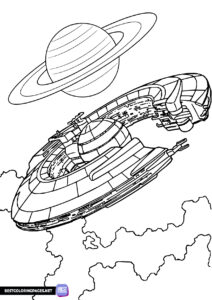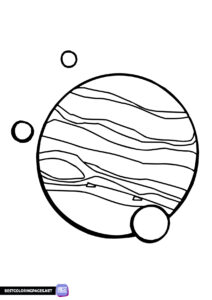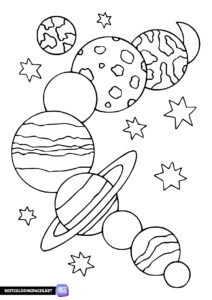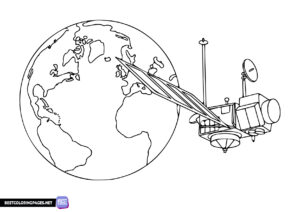Outer space coloring pages are our offer of free printable sheets for all space fans regardless of age. With space coloring pages every child has a chance to go on an interstellar journey visiting distant planets, space stations as well as astronauts working in space.
Outer Space Coloring Pages
Space and intergalactic travel adventures are a natural desire and dream of people. This desire is associated with an irresistible desire to know new, undiscovered and mysterious corners of the universe around us. And in these discoveries we are helped by intergalactic heroes – astronauts.
Our gallery titled Outer Space Coloring Pages, presents various motifs related to space and the universe. The coloring pages can be successfully used as supplementary materials for space-themed activities at school, kindergarten or at a themed birthday party.
So, here in front of you are a dozen amazing free outer space coloring pages that you can freely download and print.
It’s likely that the vast majority of us, as children, once glanced up at the sky making plans and dreams. Gazing at the stars and the moon, we wondered what it would be like to embark on an intergalactic journey in our own space shuttle and experience life in space.
Free printable Outer Space coloring pages.
Our free Outer Space coloring sheets for kids, is the perfect way for little galactic explorers to take such a trip. Outer Space Colouring Pages is a great opportunity to use all kinds of bright colors to color elements of spaceships or planets. You can also, in addition to crayons and markers, use watercolor or poster paints to give your wonderful artwork extra depth. You will also get great results by combining all these coloring techniques.
Once you are done with your space coloring sheets you can share your works on our social media profiles. It is always a great pleasure to see the works of our talented readers. In addition, if you liked what you saw here, you can share the link to our site with your family or friends.
Cosmic trivia:
- The Sun is the largest object in the Solar System. It is 109 times larger than the Earth.
There are more stars in the entire universe than there are grains of sand on all the beaches of our planet. - Venus is the warmest planet in our Solar System. The average temperature on this planet is 500 degrees Celsius.
- The sky and stars we observe, is an image created many years ago. More precisely, how many light years away from Planet Earth a given star is. For example, if the distance is 60 light years, it means that the light takes 60 years to reach our planet – so we are looking at an image from 60 years ago. In reality, the star in question may already look completely different or, in some cases, not exist at all.
- A million Earths would fit in the Sun.
- There is no wind on the Moon, which means that the footprints left by astronauts and rover tires will remain there for millions more years.
- Saturn, Jupiter Uranus and Neptune are almost entirely gaseous planets, this means that we would not be able to step on them.
- The temperature inside the sun is 15 million degrees Celsius.



























